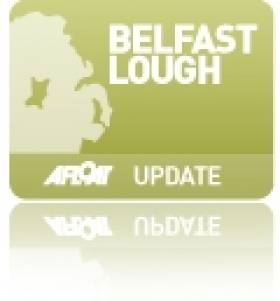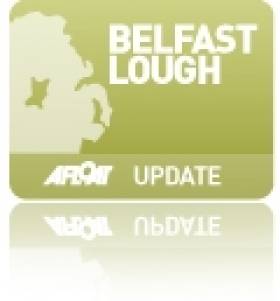Displaying items by tag: Cruise Belfast
A record cruise season for Belfast Harbour this year saw 158 calls as reported by Cruise Belfast, the partnership between the port and Visit Belfast which markets the city as a leading destination.
The announcement was made as the final cruise ship to call to Belfast this year, Fred Olsen Cruise Line’s Borealis berthed on Saturday. Due to adverse weather, the 61, 849 gross tonnes cruise ship which was to have arrived the day before, was however rescheduled to the next morning according to Belfast Harbour on social media. This took place, as Afloat can confirm the 1,353 (standard occupancy) capacity Borealis berthed after 10.30hrs with the day visit lasting until the early evening as the ship departed just after 1900hrs.
Borealis brings to 57 ships in total calling to Belfast this cruise season and from 32 different cruise operators, carrying 320,000 passengers and crew, who received a customary warm welcome. Among them were 14 ships which made their inaugural calls.
The total of 158 calls made by cruise vessels during the 2023 season marked an 8% increase on the pre-pandemic record set in 2019. On board, passenger capacities have increased to an average of around 90% per vessel.
With increased passenger numbers, and more visitors arriving into Belfast to experience the tourism offerings across Northern Ireland, Cruise Belfast estimates that more than £20m was injected into the local economy through passenger spend alone.
This year also marked the arrival of the 2 millionth cruise visitor to Belfast Harbour since the first cruise ship called to Belfast in 1996. The milestone passenger arrived onboard the Norwegian Dawn, operated by the Norwegian Cruise Line in May this year.
A further indication of the city’s growing status in the cruise industry, Belfast has also begun to facilitate a number of cruise turnarounds during the year, the largest of which saw 1,200 US passengers from the Oceania Riviera ending their holiday in Belfast and a further 1,200 starting their trip in the city.
The two millionth cruise ship visitor has been welcomed to Belfast Harbour, underlining the success of an initiative which begun more a quarter of century ago.
As the Irish News reported, cruise visitor Lea Goodsell, yesterday emerged down the gangplank of the 2,340 passenger capacity Norwegian Dawn as that milestone passenger.
The 294m cruiseship operated by Norwegian Cruise Line (NCL) will make a total of 13 calls this season and the occasion of the cruiseship visitor marked a major moment for Cruise Belfast.
In 2019 Cruise Belfast opened the first dedicated cruise terminal on the island of Ireland. It is a partnership between Belfast Harbour and Visit Belfast which markets the port city as a leading cruise ship destination.
Among the callers attracted to Belfast, Afloat adds is today's (10 May) visit of Le Bellot with 250 passengers and where the Ponant Cruises ship made a maiden voyage to the city when it docked in Pollock Dock.
While the Norwegian Dawn overnight made the short passage across the North Channel and into the Firth of Clyde to berth this morning at the Greenock Ocean Cruise terminal.
More on the story and about Cruise Belfast which was formed in 1996, preceding the signing of the Good Friday Agreement.
At that stage cruise ships came nowhere near the port city on the river Lagan, which was still emerging from more than two decades of turmoil.
As the cruise industry to Belfast Harbour continues to provide a welcome boost to the economy, the number of ships expected this season represents a 20% increase on the previous record set in 2019.
Between March and October this year, 62 different vessels from 36 different cruise lines will dock at the port carrying more than 350,000 passengers and crew.
This season will feature six embarkation cruises departing from Belfast by Ambassador Cruise Lines, a UK operator that was launched last year as Afloat previously reported. This will enable local residents to start and finish their cruise from the city.
There will also be 15 ships calling to Belfast for the first time, including Disney Dream (photo above), Norwegian Prima and MSC Preziosa, as well as Ambassador Ambition. This demonstrates Northern Ireland’s increasing popularity as a cruise destination and providing testament to the quality of award-winning visitor attractions across the region.
Michael Robinson, Port Director for Belfast Harbour said: “With 170 vessels due to dock in Belfast this year, it’s clear that cruise tourism is back on track in 2023. Last year, we had 141 calls to the Port as we transitioned from the 2021 cruise season, which was still partially curtailed by the pandemic, but this year we are on course to surpass our previous record year in 2019 as the global industry returns to full capacity.
“Cruise visitors make an important contribution to Northern Ireland’s tourism mix, attracting visitors from across the globe on day trips to attractions all across the region. We’re expecting a quarter of a million passengers to arrive to Belfast Harbour this season, which will provide an estimated £20m boost to the local economy.”
Mary Jo McCanny, Director of Visitor Servicing at Visit Belfast, added: “The outlook for the cruise industry in 2023 is extremely positive with figures suggesting we will break the record for cruise calls that was set in 2019, demonstrating the strong partnerships that Cruise Belfast has formed with global cruise operators".
"This is an exciting year for the city as the tourism offering is going from strength to strength with more visitor experiences such as the Titanic Belfast multimillion pound refresh, the launch of Titanic Distilleries and McConnell’s Distilleries and the reopening of HMS Caroline. The quality of our visitor attractions throughout the region continue to draw visitors from across the world and the Visitor Services team are excited to welcome them shore-side this season.”
Click here for the cruise call schedule.
Record-Breaking Cruise Season Ends As Black Watch Calls Time On Belfast
#CruiseLiners - It was a record-breaking cruise season that officially ended yesterday when the Fred Olsen-owned Black Watch (docked) in the Port of Belfast.
As The Irish News reports this was the 115th ship to dock in 2018, and since the arrival of the Portuguese-registered Astoria in mid-March, some 185,00 passengers and crew have spilled out into the city's shops, restaurants and tourist attractions.
Cruise Belfast, the partnership between Belfast Harbour and Visit Belfast, confirmed that the city has been named as one of Europe’s most popular cruise destinations by Cruise Critic, the world’s largest online cruise community, boosting 350,000 reviews covering 500 cruise ships and 300 global ports.
Cruise Critic chose Belfast a one of the winners of its third annual Cruisers’ Choice Destination Awards, which are based entirely on consumer ratings.
For more on the story click here in addition Afloat adds the 900 passenger /423 cabin cruiseship sailed overnight and is this morning docked at Liverpool Cruise Terminal.
#CruiseBelfast- Belfast Harbour's bumper cruise season is to have a total of 61 callers this year, among them the largest cruiseship ever to visit the port, the newbuild Royal Princess which has a capacity of 3,600 passengers, writes Jehan Ashmore.
The 141,000 tonnes Princess Cruises ship has 1,780 cabins and a crew of 1,300 and she is to arrive on 18 September. She is one of several large cruise callers attracted to Belfast because of the various attractive tourism options to offer cruise-operators.
At the other end of the cruiseship scale at under 10,000 tonnes is the prestigious Seabourn Legend which is visiting Belfast today. She is on her final cruise of Irish & UK ports for Seabourn Cruises and as previously reported she called to Dun Laoghaire yesterday.
Cruise Belfast, a marketing partnership between Visit Belfast and Belfast Harbour is expected to generate a total of 110,000 passengers and crew to visit the city by the end of October. The partnership is also to attract to the city major stop-over calls of the travel itineraries operated by the world's leading cruiseship companies.
The boost to Belfast fortunes is reflected in that the harbour as an international desination is outperforming other key UK port-cities among them Liverpool and Glasgow. In addition Belfast is now ranked as the second most popular cruise city on the island of Ireland with only Dublin surpassing in cruise visitor numbers.
Belfast’s Record-Breaking Cruise Boost
#BelfastCruiseCalls – The 2013 season will bring a record 57 cruiseships and more than 100,000 visitors to Belfast Harbour, compared to last year when only 44 cruiseships docked with 75,000 passengers, writes Jehan Ashmore.
Tourists from all corners of the globe are to visit Northern Ireland, having booked cruises with leading operators, among them Princess Cruises, Holland America Line, Celebrity, MSC, Thomson, Fred Olsen Cruise Line and Saga Cruises. The first caller of the season is the ultra-luxury Hebridean Princess, when she is to make a port of call in April.
Last month, Cruise Critic UK, the leading source of cruise information on the web, named Belfast as 'Best UK Port of Call' in their Editors' Picks Awards 2012.
The continuing success of Belfast as a destination to an international cruise market has been built from the efforts of Cruise Belfast, a marketing initiative between Belfast Harbour and Belfast Visitor and Convention Bureau (BVCB).
Anne McMullan from BVCB said "Cruise travel globally is one of the fastest growing and highly competitive areas of tourism and the record-breaking cruise ship numbers arriving in Belfast are a testament to the city's tourism success and how far we have come".
Asides the new Titanic Belfast Centre, which has arguably done for the city what the Guggenheim did for Bilbao, the port acts as a 'gateway' to the rest of Northern Ireland, where attractions are within a short coach trip to the Giants Causeway, Mount Stewart and St Patrick's Country.
































































